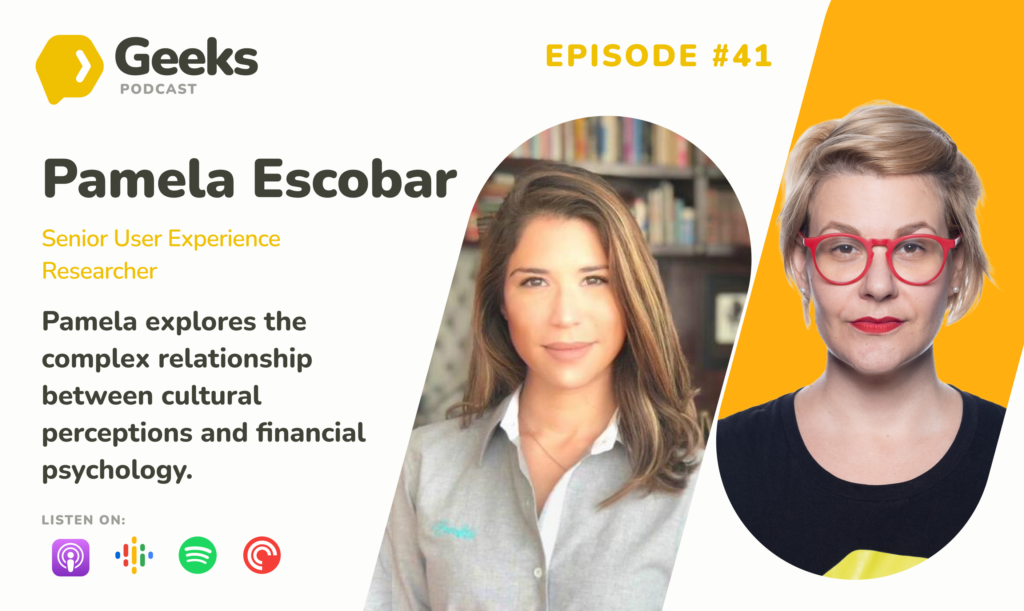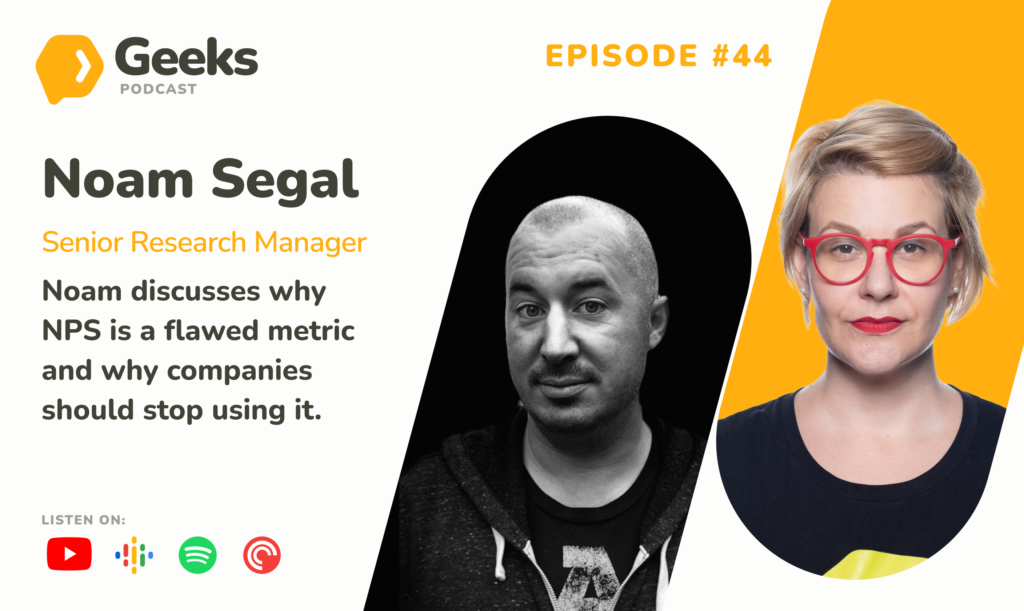Episode highlights
- 00:03:11 – Building an AI System
- 00:07:01 – Introduction to the Co-Pilot
- 00:12:54 – Future of AI in Research
- 00:22:18 – Vision for Research Co-pilot
About our guest Yao Adantor
Yao Adantor is the Co-Founder and Lead UX Researcher at Research Bookmark, widely known for helping organizations to create exceptional user experiences. With an impressive client portfolio that includes KPMG, CapitalOne, Toyota, T-Mobile, and Abbvie, Yao excels in collaborating with both internal and external stakeholders to develop human-centered products. Beyond research processes and informing product roadmaps, Yao is instrumental in leading research initiatives on emerging markets, consistently applying user-centered design principles to deliver data-driven solutions. Connect with Yao on LinkedIn or on his website to learn more about his expertise.
Podcast transcript
[00:00:00] Tina Ličková:
Welcome to UX Research Geeks, where we geek out with researchers from all around the world on topics they are passionate about. I’m your host Tina Ličková, a researcher and a strategist, and this podcast is brought to you by UXtweak, an all-in-one UX research tool.
This is episode seven of the third season of UXR Geeks, and you’re listening to me talking to Yao, the creative force behind Research Copilot. In this episode, we’ll explore how Research Co Pilot is redefining UX research by integrating AI technology with human insights. Get ready to explore the future of user experience studies and how AI is making a significant impact in this field.
What you just heard was the first intro done by NAI, which was dubbing my voice. What do you think about it? I think it’s pretty close. Although, yeah, if you now know, you can see the difference. But I thought this might be a good way how to start this episode about artificial intelligence video. And sorry for the quality of my voice in this episode.
I have been a little bit sick before, so you might hear that as well. That is not AI.
Already told you that I’m a big fan of Research Co Pilot, which is a research AI assistant. And I’m Super curious how you or Research Bookmark came to this idea. So let’s start there.
[00:01:45] Yao Adantor: The co pilot is a case of the natural mission that we have, right, to bring U. S. professionals to a place of knowledge where knowledge resides and then to be able to do their work.
Now, that second part has been really challenging over the years with Research Bookmark. It’s okay. Maybe I come to this ecosystem of learning and how, you know, we have a search engine just for UX as well. You can search there, you can get information, but how do I do my work? We’ve realized quickly that people will come, use the tools sometimes, and then they’ll flow out.
And they’ll still need help along their journey of being UX professionals, research design. So, as an opportunity came up and ChaiGPT allowed folks to build GPTs, Guess what research bookmark has is trouble, incredible amount of data on user research, how to conduct research when processing. So we’ve gotten into the flow of starting to teach this GPT how to conduct research.
So it’s not just done. Hey, learn how to conduct UX research. For us, it’s looking at how the bot actually behaves. So it’s a conversation with a co pilot, an assistant, you know, that helps you and both the bot learn stuff or the AI learn stuff. But it started as a natural connection to our mission to bring US professionals to a place where they can share knowledge, learn, and grow in their careers, really.
[00:03:11] Tina Ličková: I’m also curious because I never built my AI system on my own, how long does it take to build something like this?
[00:03:20] Yao Adantor: Ironically, it’s pretty instant. You can go on a GPT and tell it to do something today. So the initial action is instant. It wasn’t like it takes a bunch of engineers to, to build it or to, you know, it’s natural language coding.
So it’s instant, but actually making it do the right thing is we’re still in the process of this 0. 1 really. We’re still in the process of helping it become better every day. As we get feedback from folks like yourself, we use it ourselves, we get feedback, we then improve. So I think it’s going to take months to get it to a place where any user experience professional can come and be satisfied with it.
But years to perfect it. I think it’s, it’ll never be perfect. It’s continually moving as train changes, methods changes. Whatever people are looking for now, we’re going to help and teach you how to do that.
[00:04:17] Tina Ličková: Maybe I can share a little how I’m using it because I started to freelance in May this year, last year, sorry, 24 already.
And I sometimes feel, especially With this client that I’m working on a little bit alone, I would say, and it really helps me sometimes to have this conversation without waiting for answers of my friends and colleagues from the business, or what do you think if I approach this like this, so I am sometimes starting with, Oh, this is my task, this is my goal.
What would be your approach? This is one use case that I see. Another one is that I’m sometimes sharing my scripts for interviews with the customers of my customer, just to see if I’m going the right path. And Research Coppel also offers me additional questions, which I don’t usually take as they are, but they give me great inspiration.
Last one was, yeah, I asked research co pilots to promote itself. And that’s where I posted it. And it’s told me also that Julian Della Mattia, who I’m greeting with this. Yeah, I had, I had to do something about it and he was super surprised.
[00:05:29] Yao Adantor: So it’s, let’s talk about that for a second, super interesting.
Cause I woke up to a notification and like, wait. What’s going on? The co pilot is consistently being fed everything we’re doing. And that week, I don’t know if that week or the week after we were having our last, uh, webinar of the year, which was around networking and UX. And Julian was part of that. So we were hitting it, everything or Eventbrite, whatever know about us, because one of the goals is for the co pilot to connect you to the ecosystem.
Right. The co pilot has specific set of skills. But how do we help us professionals understand that research bookmark has? newsletter, live webinar and learning classes and so forth. So we’re trying to help it understand also our contents. So Julian Nesko was like, again, another thing we could have not predicted with the chat, the GPT is people’s limb coming up was like, Oh, learn how to do research operation like Julian.
For example, it’s broad, but it may be able to take some of his learnings online and broadly help people understand more about that. Yeah.
[00:06:41] Tina Ličková: I don’t think Julian found it that funny. It’s the early stages, but it still can connect dots. I mean, so it’s just putting it into the right way, and I’m happy that we are addressing this.
And thank you for explaining. Let’s go back to the use cases. What other use cases do you see for a researcher where it can help you?
[00:07:01] Yao Adantor: The research co pilot sits specifically at a place to help eliminate. A redundancy that we see, right, in everything, research plan, this is the template, this is that. These things we know are kind of part of our work, but the real work is speaking and connecting with our stakeholders, connecting with our participants, you know, conducting studies, and then being able to bring valuable analysis back.
This everyone does, no matter if you’re a freelancer or you work in B2B or B2C, you’re conducting research, you’re analyzing, and you’re communicating with someone. So the co pilot, it’s. sits exactly around there. I’m starting research. I just had a conversation with a stakeholder that is talking about, you know, conducting research on subject a, because we don’t know anything about it.
Sure. How can we take that and turn it into blood that makes sense for not only you as a researcher, but obviously at the beginning of our work, we connect with all types of stakeholders, try to align. Coming from this meeting with what I’ve learned. Help me put together something general that can help me start that that thinking process.
It obviously has a lot to do with speed. It makes you faster as a practitioner, but more than speed, because speed is not quality. You still, you still need to guide it. But it eliminates that blunt words of just creating a format that people can understand. We just left the meeting. Imagine me coming back before the end of that day and presenting a simple one pager on the objectives of what we’re about to do.
This helps us start a conversation right away. The fire of kick starting a new work didn’t die, right? And then tomorrow it can be refined from my stakeholders notes or it’s perfect. And we get to move forward with the other steps. So from starting research, bringing data into it, analyzing all this data, we’re not looking at, we cannot see the data chat, open AI themselves, cannot see the data that you’re putting in there.
They’ve been very open about my privacy. So bringing in data and being able to analyze and the output. Charts, and we’re teaching it how to really do research analysis for user experience. This is different than using the general GPT and just doing whatever. So it helps anyone, whether you’re a freelancer or you’re on your own.
And especially if you are starting in the field of user experience. Right, because some of the things it does, and we’ve been able to have it do now is you’re, you’re starting, you’re maybe a younger, you’re starting new or a specific method. You’ve never done it before. It can walk you through learning about that method as well.
It’s not just about getting the answer. It’s also, it’s also being thought to teach while doing, which is the best kind of, which is what I call augmented learning, right? It’s the best kind of learning. You’re doing while learning at the same time. So it’s, we’re really trying to curate this behavior as is asking you questions back and forth and you’re answering and you’re moving on and getting what you want, you’re also learning about, wow, I didn’t know what that was called.
This is a new method of, or a new way of looking at the work I’m doing. So it’s a bottle shell on its own. It can do everything, but the thought is what do you want it to do? How do you train it in that specific way UX professional?
[00:10:20] Tina Ličková: Maybe the more traditional people will argue, it’s not good for the beginners because it’s, they have to learn the basics first, but I like your point that it actually can learn you and lead step by step.
But I’m wondering with that, how much can a beginner rely on what research co pilot is telling because. This is where I struggle a little bit. You know about the Chat GPT hallucination, so how much hallucination, yeah has research copilot, do you think?
[00:10:55] Yao Adantor: Knowledge is about your angulation, right? You can never rely on a sole source to teach you or know everything.
So let’s start from there. If you are learning anything, user experience or otherwise, you triangulate knowledge. So what we essentially want to happen or the behavior that we’re looking to like cultivate. Is this of the co pilot being there for no matter where you start, especially starting you need a bit of handholding.
And right now, it seems like to me, all of the sources that are also out there are on their own YouTube videos. Say what is a semi structured interview? No one is there. You don’t know if it’s true or not. You need a triangle. You might have to look for another website, another book to say. Oh, this is knowledge.
So the copilot is part of that. It will give you a general knowledge and direction. Some things it can go deeper in, but I’ll behoove anybody using it and learning from it to try to triangulate that knowledge using our search, for example, right? Our search is pulling from the web and filtering out any of the crap that is not UX related.
So you can try to take our knowledge and go on a search and type the same thing and see what is new. What if Nielsen Norman or whoever’s name you just talked about it today, our search will bring it up. So you can triangulate that knowledge using our ecosystem pretty fairly. Now, as these AI models get better, there’ll be less and less of an error.
But again, to avoid all of this, we are training specifically to be a UX professionals compiler. Not just a research, not just, so everything from the beginning, everything we define while building research bookmark is being thought to it. So it has a great foundation. So that’s how we eliminate a lot of the random answers and hallucinations kind of stuff right now.
[00:12:54] Tina Ličková: I love the fact that everybody’s talking about AI in our business, but you actually did something and I appreciate it. Let’s geek out a little bit. What is your vision on. Where AI is going to take creation to the next years.
[00:13:11] Yao Adantor: If you’re not doing this already, get back out and talk to people in person.
Start to cultivate skills that are face to face based, you know, especially right through COVID, we started doing a lot more remote interviews. It’s easier to reach people in some ways, but we also lose a lot of, a huge percentage of face to face. And other being said that you might not get through doing talking remote.
So I’ll say the one thing is going to affect, let’s talk about the positively is get researchers back out in the field. I like being in a field. I like talking to people face to face. Not every situation dictates it. It’s not every time that you need to go and waste company money. But some, to, when you, especially when you’re really looking at improving experience on something that’s been faulty, you want to be in the field, right?
You don’t want to keep collecting data through attitudes, just this face to face interviews over a screen. So I think AI is going to affect that. Companies. We’ll turn or I’m hoping that no, no one’s predicting the future, but I’m hoping companies will turn some of those that budget to going into the field.
So actually investing that into the research participant relationship so that we can go and see people. And this is being due to a lot of the other work being eliminated through the use of AI. So every tool you’re using today, whether for analysis. It’s probably using some kind of machine learning, and they’re probably going to use AI, right?
And every tool, your repository, your transcript tool is doing analysis, actually, right? There are tools out there now that just this interview will be transcribed as a research, analyzed, thematically analyzed, and then shot out for me. Okay, so if that work it’s going to happen is only going to get better, let’s be honest about it, it’s going to get better and easier.
What do they need you for as a researcher? Wow. Now that question becomes, it’s a real question. If the product manager can launch research on their own, analyze, broadback, answer, what do they need you for? Oh, this is the 97 percent part that we didn’t get from the face to face interview. Is in the person, is longer term studies, more complex studies, diary study, eye tracking, being able to set up thorough and more robust studies is what they’re going to need a human for.
Right stuff that we cannot readily automate to AI. So that’s how it’s going to change. We’re going to be doing more complicated stuff. I think if user research keeps becoming its own pillar and growing, it’s going to become more scientific. So right now there’s. As there’s a, always talks on returning investment of user experience, or if you do research, does that really mean there’s a huge return on investment of dual research?
And maybe it’s hard to put, maybe not, maybe we’re, we’ve been trying to calculate it in our own number, but really we just look at the revenue at the end of the year and say, we participated in that because we were able to do something. So I think as those things are changing, AI is going to bring about a lot of those changing changes, and I’m hoping it pushes some of these through things like, again, conducting research in person, being face to face, more human with people, and then on the other end, it’s going to fast track work to the point where it is going to, but if you don’t have the right skills, And you’re not in a community like research book work, you’re not learning and feeding yourself every day is going to make you liable to not, to not succeed in the industry.
Because as far as I know, as far as I’ve seen, business will not keep investing in something that they can automate, they can readily automate. If you’re just doing research like a robot, there’s no point of you being there and everything that, that, that comes with that. But if you’re doing more. If you go into where we really want to go and touch more of our users and such, there’s going to, it’s going to reinforce that.
[00:17:14] Tina Ličková: Two points to that. One is I wouldn’t frame it as researchers doing more complicated stuff, but maybe researchers doing more strategic at. And impactful stuff could be, but that’s just words not to correct.
[00:17:30] Yao Adantor: Yeah. Well, yeah, it’s going to affect a lot of things. We cannot avoid the fact that we do a lot of redundant tasks like over and over again, even through analysis, generating documents, we do a lot of redundant tasks and those need to go away.
So we can do, like you said, more be earlier in a conversation, have more impact. And see our users, go talk to our users in person, have conversations with them on why they’re spending their hard earned money on our product, or they’re giving us their time, go talk to them.
[00:18:05] Tina Ličková: Now I got the second point because now I am doing a lot of research in meteorology forecasting.
Yeah. It’s super interesting. And I mean, it’s scientific software, so you can imagine how I am jumping every day from the bed and like, yeah, what’s new today. And as you were talking about it, I am working for this client for about a half a year, but in December I had. It tends to be in the forks, which is called tower, in the main tower.
And to really observe forecasters and speaking to them because they love to speak, they love to involve you and show you, give you the feedback to the tool that we are building. And of course, the question of AI emerging in that field as well, it could immensely help with interpretation. Meteorologists already see now.
Um, even if they’re have very simple products, which they’re sending out to their customers, it’s always, Oh, they need to be told from us. So they need the messenger has to be human. And this is why, what I want to emphasize, like he had the human contact, we lost it in COVID and they’re really like the perspective you are giving off.
Getting back to the, into this human contact and getting out of the human stuff.
[00:19:17] Yao Adantor: I think those are some of the exciting things about user experience. When I found the field is this ability to say, Hey. Look what I’m doing. Do you like it? What do you think? It’s so vital. And we do that through maybe there are tools I’m trying to use, not use any names.
There are tools that will help, you know, do concept testing and all of that now. But the key element is being in a cultural study next to the person maybe observing people in their natural habitat using a product. This gives you a An incredible amount of insight. And I think that insight gives more value to what you, what research can do.
And it gives more value to research in general. So yeah, I’m, I’m absolutely for breaking out of structured interviews on zoom all the time.
[00:20:07] Tina Ličková: My recent work, I was preparing CoriColon for internal UX and research training for my client. And I realized I somehow have to put the AI buzzword into it because they are going to ask for sure.
But I’m also seeing them as people who like to experiment and explore new things, going to chatGPT and asking them questions in research. So I built a few classes on like how to prompt. Um, and I want to show them a research cop out. So they’re using the stuff that actually is built for it. What would be your advice to anybody trying to do this with their stakeholders of what to be aware or what to teach them?
[00:20:46] Yao Adantor: One is that to understand that the AI is an addition, is an enhancement, right? Like the calculator is an enhancement to doing mathematics for a merchant back then, right? Much faster, but you still need to check your work. If you get to the end of that calculation and it sounds like it’s not right, It’s likely not right.
Artificial intelligence is biased, right? It’s been trained by human beings. At the end of the day, it’s been built by human beings. So you need to be aware of its, um, constraints. Just list out its constraints first. Say, hey, this AI can do a lot of stuff, but we know that this and this needs a second human look and it needs it thoroughly.
So now you eliminate a human being’s 15 hours draft in this document, but you use those five hours to really improve the document, to reach perfection at a much faster rate. I think those are some of the things to mention first is, what are the limitations of this AI that we’re using? And then what are our guidelines to checking our work?
Right. It’s helping you, but you have to check. So actually a focus on checking thorough work and making sure it responds to the way you, it behaves the way that you intended. It’s number one, because they can do anything, right? It’s not just a calculator. It can do anything for you, but you need to have your own guidelines on what, how you want it done.
[00:22:18] Tina Ličková: I’m going back to the beginning where we were talking about it and how much time did you spend on building research co pilot? Where would you like to see research co pilot also in kind of the ecosystem of research bookmark in the next months, maybe even years.
[00:22:36] Yao Adantor: I want it to naturally flow into the US professionals work.
So actually in a couple of weeks or right around a month, when you go and research bookmarks, you’ll come more into an ecosystem of. Tools that help you grow more than just a search engine. You’re going to see a newsletter. You’re going to see our classes, our apprenticeship program, so that you can walk into, choose your own adventure.
And I would like to see the Copilot be a strong foundation in a UX toolbox for any professional. We are. Reaching designers and how they do research and how to do their work as well. We’ll end up, research book work essentially will end up being the hub, the train station for our UX knowledge. This is the goal, but it’s starting at a fundamental level, which is research.
And then we go from there. So I want to co pilot to be able to help any UX professional in whatever their obstacle is in that work process. Whether they are about to have a conversation with a stakeholder and they’re like, I’ve never talked to this person. We’re talking about, I don’t know, construction, a subject I’ve never worked in, what are some questions I can bring up that are along the lines of experience that can help me deal with a relationship with a stakeholder.
You can use a co founder for that, right? Like deeper stuff. You can use it for basic analysis. You can use it to give you the right type of language to speak to a specific set of, to a CFO, for example, or a CTO, right? They’re looking for different things out of your research. You’re not looking at the same thing as a PM or the designers.
How do I speak to them? What do I use, right? So you can use it for, I want to see it be workflow of every UX professional. Whether it is bringing about examples of layouts and how, you know, why, and It should be able to do all of that. So that’s what we’re training it for. And as part of the ecosystem, it should strengthen the search.
Hopefully we get to build enough of technology to connect it to the search. So maybe even in the future, we’ll eliminate search. The copilot will be the search. It will be everything we can only dream. Uh, but it all goes in line with our mission of. This ecosystem that any UX professional anywhere in the world on any device can use to learn and grow their UX curators.
[00:25:03] Tina Ličková: Thank you. Again, I learned a lot.
[00:25:06] Yao Adantor: Thank you. Thank you so much. I really appreciate talking to you.
[00:25:08] Tina Ličková:
Thank you for listening to UX Research Geeks. If you liked this episode, don’t forget to share it with your friends, leave a review on your favorite podcast platform, and subscribe to stay updated when a new episode comes out.
💡 This podcast was brought to you by UXtweak, an all-in-one UX research software.















